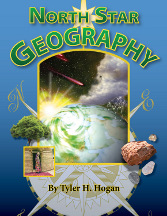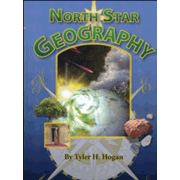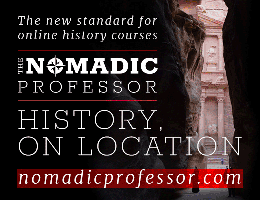North Star Geography is a comprehensive geography course for students in junior or senior high. The course can be adapted in many ways to require more or less time. It might be completed in as short a time as one semester or as long as two years.
Components of the course are a physical textbook and a digital Companion Guide. The text is designed in full-color with quite a few illustrations. It has a significant glossary that doubles as an index. The Companion Guide includes a complete copy of the textbook plus all other essential course components: vital scheduling charts, quizzes, a final exam, answer keys, maps, graphic organizers, and much more.
The course is presented in three units: Geography Skills, Physical Geography, and Human Geography. Human Geography encompasses cultures, environments, heritage, religions, governments, and economics as well as their influences upon one another. The course is written from a broadly Christian perspective (not favoring any denominational views), and this is especially evident in the Human Geography lessons. There are 16 lessons in all. To complete the course in one year—the option I think most homeschoolers will select—requires students to finish one lesson every two weeks.
The text focuses primarily on broad general topics with occasional sidebars about specific places. For example, a sub-section of lesson nine that teaches about “Flora” has sections on the carbon cycle, the nitrogen cycle, plant diversity and plant kingdoms, and plant adaptations. This section concludes with a sidebar on “The Amazon Rainforest.”
The Companion Guide reinforces text material with note-taking pages, activities, and quizzes. Suggested activities range from watching videos, making a “karst cave out of clay and sugar,” and making your own compass to making your own hydroponic garden, orienteering, and researching your own ethnic roots. There are activities to appeal to different types of learners as well as some that are quick and easy and some that are complex. Activities requiring materials include lists of what is needed. You can choose those that seem most useful and appropriate for your student. Students should not try to do all of the activities.
Graphic organizers on the Companion Guide include some forms used with various lessons in the text. A form for investigating cultural treasures is used along with lessons on cultures, and forms for identifying a student’s elected officials at federal, state, and local levels as well as a candidate comparison form are used with the lesson on government.
The Companion Guide also includes a parallel strand of study not included within the text but which is a major part of the course. This strand directs study of continents with map work, memorization of geographical locations and features, and some cultural research. In addition, research questions related to the continent being studied help students learn how to search for specific information, most of which is available on the internet. “Atlas Building” assignments include map work (political, physical, and thematic maps) and completion of graphic organizers. Graphic organizer forms include World, Continent, and Country Fact File forms with space for specified content to be filled in. Other forms for investigating the physical and “human” geography of a particular region are used as part of a final project.
Suggested schedules in the book show which course components might be eliminated for those lacking the time or needing to simplify the course. Schedules on the Companion Guide provide more detailed information as to what should be completed each week depending upon the time allotted for the course.
Students can work through the course doing much of the work independently. However, some activities (e.g., orienteering and other field trips, games, experiments, performances) really make the most sense with two or more students, and a co-op class meeting periodically might be a great way to get the most out of the course in an efficient manner.
When I first looked at the North Star Geography text, I wasn’t terribly impressed. It’s a great looking book, but it seemed a little light on content. But once I discovered the wealth of content on the Companion Guide, I realized that this course offers a significantly different approach to the study of geography for older students, and I totally reversed my opinion. While it does not provide as much detailed information about countries and cultures within the textbook as do some other geography courses for these levels, it does a great job on map work and the important elements of geography, and then it directs students to do their own research to discover the detailed information—a more effective way of learning the information.
The unusual course design coupled with the variety of activities and the use of “investigative learning” make this course a great option for learning geography.












